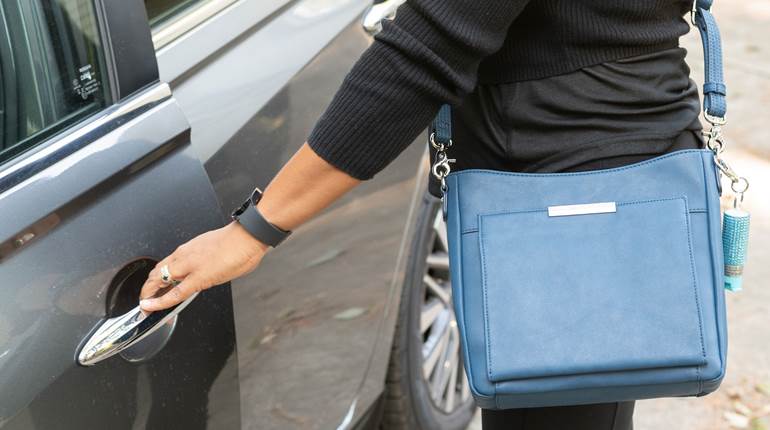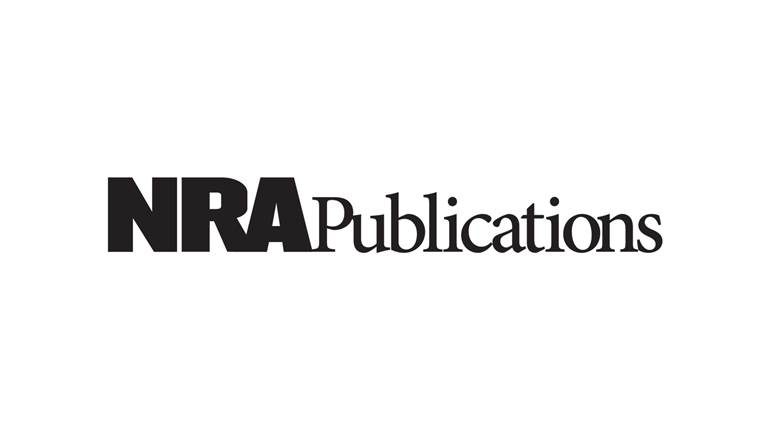What has become known as “The Ladies Pistol Project” (LPP)—an internal code name assigned to one of the largest examinations by American Rifleman of the burgeoning interest in handguns by women—began as a simple question: Are certain models of handguns, regularly purported as “female friendly,” really that? And what exactly defines that term?
If you are reading this, odds are you are a man. At least that’s what our demographic data suggests. If you are, we invite you to keep reading, because although the information contained in this article was created by and about women, it is particularly pertinent to male spouses, relatives, friends, pistol instructors, gun store clerks or any others associated with women and who may have introduced—or hope to introduce a woman—to target shooting or personal protection with a handgun.
What we learned corroborated some theories while debunking one of the most common schools of thought long perpetuated about what constitutes the ideal firearm for a woman. This knowledge, compiled from supervised and unbiased, hands-on assessments by amateur shooters—women like your mothers, sisters, daughters, wives, friends and customers—must be shared if we, as a nation of men and women, endeavor to continue to exercise the rights we enjoy under the protection of the Second Amendment.

The Genesis Of The Ladies Pistol Project
I am regularly on the lookout for opinions regarding handguns that a woman should consider for purchase and ownership, and, more importantly, for routine practice and use. I’m talking about information found in forums, blogs and articles from those who have actually bought or had experience with a particular gun—not a 1989 magazine article that espouses the Smith & Wesson LadySmith line, one of the industry’s first modern attempts at aggressively marketing handguns to women, as being perfect for the “little lady,” because hey, you know, it consisted mainly of revolvers.
If I noticed that a particular handgun model appeared on multiple lists, I added it to a growing lineup of “guns to try one day.” It was subjective, perhaps, but a good place to start nonetheless.
The “one day” came when I was asked to write about the need for more female NRA Pistol instructors. Indeed, there is a growing demand for female-taught classes in response to the surge in female gun ownership, which has outpaced the supply of female instructors by light years. Some evidence suggests that many women prefer to be trained by women, so to merge the discussion of a trend toward female-led instruction with this long-dormant pistol project was an idea whose time had come.
“I don’t believe there is such a thing as a ‘female-friendly’ firearm,” said NRA Pistol Instructor Karie Thomas, who is also the NRA Publications’ firearm inventory manager, and sees a considerable number of handguns cross her desk every week. “I believe there are firearms that are better suited for different skills, different activities and different hand sizes.” Thomas, an experienced competitive shooter, also served as a tireless range officer/statistician in facilitating the exhaustive shooting portion of the Ladies Pistol Project, which would ultimately result in 35 women firing 18 pistols. Was she right?
NRA Instructor and Ladies Pistol Project assistant Martha Amitay said that through her experience training women, and especially since the Ladies Pistol Project, she has observed that a female-friendly firearm is one that “fits a woman’s hand properly, one that she can get a good grip on, one in which the trigger is easily functioned and one that does not have too heavy a recoil spring.” Granted, this is not unlike certain opinions voiced by numerous male shooters. Comfortable, enjoyable shooting begets more practice, higher proficiency, more confidence and, therefore, more enjoyment, which is a gender-neutral, universal truth.

But the burning question remains: Which guns, specifically, do women prefer?
Amitay said that it is not uncommon for women to arrive at her pistol class with the “wrong” gun. “If they’ve been given a firearm by a friend or spouse who bought them a firearm, it is not always the best choice for them.”
I am the poster child for that claim. Most handguns I fired in my younger days had been designed, understandably, with a man in mind—huge slab-steel revolvers and M1911s—and, in my household, they were most definitely purchased by a man. When I visited the range, it was always someone else’s handguns I fired. To be fair, materials, manufacturing technology and bullet construction—as well as the approach to design and even business decisions—are far more advanced and diverse today, so handgun choices, by comparison, were more limited back then. These days, thanks to the thousands of models on the market, it usually comes down to the gun’s intended purpose.
“The type of firearm that you end up purchasing is going to be vastly different depending on how you’re going to use that gun,” said Debbie Crews, NRA Range Manager and Ladies Pistol Project assistant. “Are you going to purchase a firearm to keep in your home for self-defense? Do you eventually want to carry concealed? Are you just getting a gun so you can go to the range and shoot recreationally?” These are questions all gun buyers must consider before making a decision to buy any firearm.
Thankfully, there is greater diversity in this golden age of choice that provides the buyer—female or male—with more refined options. Personal preference is a right as well as a responsibility, and one’s opinion and comfort level should neither be ignored nor the subject of negotiation—an underpinning philosophy for the Ladies Pistol Project.

The LPP Commences
For many years it had been my desire to assemble a day at the range for friends and acquaintances who, once they learned I worked in the firearm industry, had asked me to take them shooting. Today the notion of gathering a group of women to shoot handguns is no longer a rarity, nor uniquely mine; rather, it is now, happily, a more common occurrence.
In the summer of 2016, I invited five female friends and colleagues, all of whom were inexperienced shooters and who had expressed interest in learning to shoot (or shoot better), to take the NRA Basic Pistol class and then try out some purportedly female-friendly handguns. Obtaining a certificate in NRA Basic Pistol required online study, supplemented by a one-day classroom session in order that NRA instructors could validate their knowledge, followed by a practical range session to determine shooting proficiency. Successful completion of the blended-learning course would provide the necessary credentials to apply for a Virginia concealed-handgun permit.
For the range session, the five women chose their favorite from among the handguns I brought in for the project, a selection they made during the classroom portion. They made that determination based on the handguns’ ergonomics: overall size, grip, trigger, ability to manipulate the slide or load/unload chambers of a revolver, work the magazine release, slide stop and other controls, and dry firing. There was ample lively chatter among the ladies to indicate the revolvers were early favorites, but it was yet to be revealed how those early opinions would translate during live range fire.
In addition to the eight pistols recommended by the internet community, we included a number of other guns that I hadn’t considered but were wisely suggested in order to offer a broader perspective on frame sizes and actions, with the hope of providing for a more balanced choice for the three different hand sizes. All told, we settled on 18 guns, more than double the number I initially sought to test. To keep the sample size manageable, we chose only 9 mm Luger or .380 ACP models for the semi-automatics, and nothing larger than .38 Spl. for revolvers, as those were the chamberings that were most recommended during the initial research for ideal pistols for women.

Meanwhile, Back At The Range
The women returned to the range on another day for the option of firing one, or all, of the remaining 17 guns they hadn’t fired during their Basic Pistol class. The purpose would be to rate the guns on a variety of criteria detailed on a survey, which they completed upon firing each handgun.
To ensure a better sample, the invitation was extended to the entire female NRA Publications Division at large, as well as to spouses of some male colleagues. As further insurance for a good turnout, the invitation was extended to other employees within the NRA Headquarters building, and then to members of a local chapter of The Well Armed Woman. The response was so positive we had to cut off the number when it reached 35, actually turning away many women who had heard rumors about the opportunity to test different guns. I was gratified and humbled by the fact that all 35 women chose to fire all 18 pistols, not because they had to, but because they wanted to.
For Debbie Crews, it confirmed what she already knew about women and guns. “Women have the really amazing ability to just stick with it,” she said. “It just reinforced my knowledge that women are very committed to not only learning, but learning correctly, and that we do want to be participants—we do want to learn to shoot these things.”
For American Rifleman’s Kristen Voss, the motivation for shooting all 18 pistols was to leave no stone unturned in her search for the perfect handgun. “It gave me a chance to see what handgun I’m comfortable with since I didn’t have much prior handgun experience,” she said. “I wanted to see what fit my hand, what I was comfortable shooting and, if I were to get a concealed-carry permit, what would I be confident carrying.”
American Hunter’s Rose Bier said the project gave her the confidence to go the range. “Before, I didn’t even know what type of pistol I would like or what I should get. When I go to range I want to be able to have my own gun, so where do I start?”
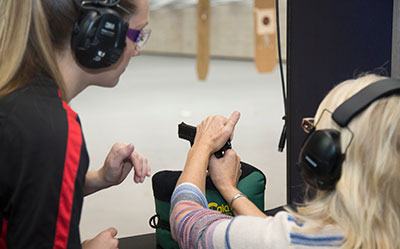
What We Learned
Not unlike a speed-dating session, some potential partners were rejected because they just weren’t the right fit. Comfort and function, trigger press, perceived recoil, or sights that didn’t lend themselves to proper or consistent alignment, were typical causes for dismissal.
Coincidentally, two of the pistols that landed in the top five had previously been awarded NRA Golden Bullseyes in the “Women’s Innovation Product” category, named by the editors of NRA Official Journals. The Walther CCP was Shooting Illustrated’s choice in 2016, the second year the award was given, and American Rifleman named the Springfield EMP4 its 2017 winner. Would the women agree with our editors?
And what features did these two guns possess, with two entirely different operating systems—one a delayed-blowback, striker-fired, polymer-frame gun, the other an M1911-style hammer-fired pistol that had been sized for the 9 mm Luger cartridge—that made both editors and these women identify them as great for women?
The Walther CCP had quite a few things going for it. In fact, it was hard to find anything the women didn’t love about it. They remarked positively about the pistol’s size, weight, recoil management, the textured grip and simply the fact they were able to shoot it well with good results. Remember, this was about the ability to shoot the gun.
The Springfield EMP4 gave the women some insight into the love affair that many men have had with the M1911 for more than 100 years. Although the textured wood stocks and the red fiber-optic front sight provided enough of an ergonomic advantage to push the gun into the running of favorites, it was the smooth press of the single-action trigger that left them wanting more.
The SIG Sauer P238 earned the highest overall rank in the survey. Ironically, the little SIG, a .380 ACP pocket pistol, found the most favor with those ladies who have larger hands. It was praised for its effortless slide manipulation, bright sights, single-action, M1911-style trigger and superb recoil management. All of the women shot it well. “We often hear this feedback directly from women who shoot the P238 and from trainers, as well as retailers who sell the gun to ladies,” said Tom Taylor, chief marketing officer and executive vice president of commercial sales at SIG Sauer. “It is a visually appealing gun, but more importantly, we believe it is a more functional, accurate and comfortable gun for women to shoot because of its quality, weight and trigger.”
There were, however, features about each of the pistols tested that the women liked—there just wasn’t enough of a consensus on some to earn them a top ranking. So our “Frankenstein Gun”—a fictional pistol, if built, would have included the following:
Trigger: Heckler & Koch VP9
Magazine Release: Bersa Thunder Pro XT
Slide Stop Lever: SIG Sauer P238
Sights: Smith & Wesson M&P 9
Recoil: Smith & Wesson 67-5
Loading/Unloading: STI 5.0 Marauder
Grip width/Circumference: Walther CCP
Weight: Walther CCP
Revolvers
So what about male influencers who, for decades, had tried to pigeon-hole women into buying those small revolvers—the implication being that a semi-automatic is too complicated or too unpredictable? In short, they were wrong, at least when it came to the smaller-frame revolvers. In fact, the numbers revealed that, of the four revolvers included in this exercise, only the larger-frame Smith & Wesson 67-5 placed anywhere but at the bottom of the list in terms of favorites.

Certainly there are women who can and will choose a small revolver, and if you like your revolver for its reliability as a concealable wheelgun, then by all means, keep your revolver. For me, too, old habits die hard. The Chiefs Special handed down to me by my husband 25 years ago is never far from reach in my home—although these days my Springfield XD(M) Compact, with 19 rounds of 9 mm Luger, and my new Glock 43, are usually a bit closer. Well-respected female Gunsite instructor Il Ling New is all about the S&W 360 PD, a hand-punishing .357 Mag. DAO revolver, but it’s important to know she is considered an industry icon in the gun-training circuit, so that says something about the necessary skill level someone might expect to properly work those heavy-triggered revolvers.
This project is not and was not intended as an indictment against small revolvers, particularly the J-frame, which continues to be one of the best-selling guns of all time. To the contrary, we applaud that first step taken decades ago by a gun manufacturer to be inclusive in its blueprint for a future customer base. Smith & Wesson had great foresight and paved the way for projects like this.
However, the majority of the women in our survey—many of whom were relatively new shooters and not involved in personal-defense training—expressed distaste for the platform, particularly after learning proper slide manipulation for each of the semi-automatics presented.
“I dislike revolvers. I dislike them all across the board,” said Rachael Herbert-Varchetto, assistant editor for America’s 1st Freedom. “The kick was just too hard for me, and I found it harder to bring back down to a shooting position for the next round.”
The school of thought that women do better or should be working with a revolver, as well as the assumption that it should be small ... “That’s a very old view,” said instructor Amitay. “It doesn’t take into consideration that women are perfectly capable of physically and mentally handling any firearm that’s out there.”
Donna Worthy, a retired Baltimore police officer who founded Worth-A-Shot, a Millersville, Md., gun store that also offers handgun training and concealed-carry classes, sells guns to women on a daily basis, and concurs with the common misconception. “Semi-automatics are a better choice for women if their hands have enough dexterity to be able to use them,” she said, the main reason being round capacity. “In a high-stress situation, I know that you’re going to be missing a lot of shots ... we want a little more in the magazine if we can have it.”
Worthy also points out that the trigger pull on a semi-automatic is much easier for a women, as most revolvers are going to have anywhere from a 9- to 12-lb. trigger pull in double-action mode. “That’s a heavy trigger to be pulling with one tip of the finger.” In fact, all but one of the 35 women ranked the revolvers as their least favorite, exemplified by one J-frame DAO revolver in .38 Spl. that exhibited a trigger pull long and heavy enough that several women weren’t able to complete the task. Sarah Young, who works at NRA Headquarters, summed it up best: “I definitely do not like revolvers, despite the common adage ‘give a woman a revolver.’ I was not comfortable with them—at all.”
Going into the project, many of the participants believed that they would want to shoot only the revolvers. And, based on the classroom gun-handling session and the wheelguns’ fewer moving parts—that oft-repeated “very old view”—they expected to be most successful with revolvers on the range. While that early assumption was not entirely untrue, they did not expect to discover that by using the proper push-pull technique in working the slides, they could shoot any of the guns laid out on the bench. Technology and materials, coupled with proper training, have changed the landscape in options for semi-automatics. It was an epiphany for many of the women when they realized they could reach for the Smith & Wesson M&P Shield and run it better than they could the company’s Model 442 revolver—a gun that has long been marketed to women. Bottom line is, before you buy her a revolver, allow her to first shoot it and let the decision be hers.
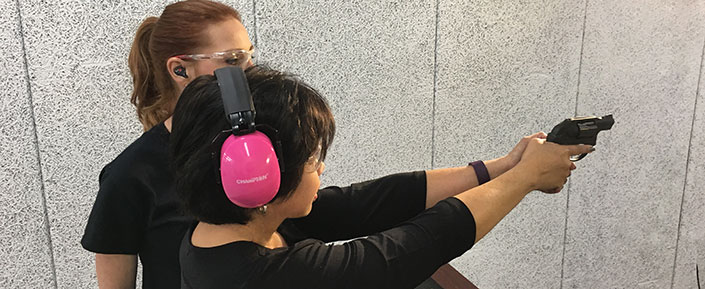
What The LPP Wasn’t
It is important to understand what the Ladies Pistol Project was and what it was not. First and foremost, it was not a scientific study. Those are best left to experts in methodology, analysis and official focus groups, such as those conducted by our friends at the National Shooting Sports Foundation. Other than the additional firearms recommended by my colleagues, there were no control groups.
The guns chosen were not specifically carry pistols. While not mutually exclusive, for purposes of this project, concealment was not a primary focus. Ultimately, the question was: Can women easily run these guns? It was all about usability, not concealability.
The Ladies Pistol Project was, however, an experiment with opinion-based results. It was a thoughtful examination of selected handguns by a sizeable group of women—most of the firearms being chosen based on favorable anecdotal reviews. Many of the guns had long been on the market, and none had been specifically marketed by their manufacturers as a “women’s gun.” And there was no consideration given to whether a manufacturer bought advertising on an NRA property.
The Ladies Pistol Project was a snapshot in time. It’s what we learned in the summer of 2016. We hoped that the information could reach women who didn’t have the benefit of participating in this experience or easy access to a range or a variety of pistols. Through our survey we asked relevant questions, and gathered useful and unbiased information from each of the women who participated, who could use it for their personal pistol-selection purposes going forward. And ultimately we hoped, and continue to hope, that it would ignite the spark of interest that these ladies already showed in learning more about how to choose the proper gun for use in both recreation and personal protection.
The LPP garnered so much interest, it became the opening episode of the Summer 2017 season of “American Rifleman Television,” which airs Wednesday nights on the Outdoor Channel. That episode is scheduled to re-air on September 6. Watch a preview here. As we go to press with this issue, we are completing Ladies Pistol Project II—with 50 women firing 24 guns designed with concealed carry in mind—some of which were not yet on the market in summer of 2016. We'll share those results with you soon—as well as answer the question I have received relentlessly since the project concluded: What about the Glock 19?
The Survey
*Firearms without a slide, slide-stop lever or external safety were not penalized. a point was deducted only if they were not easy or comfortable to manipulate.
Guns Tested By Chambering & Type
9 mm Luger Semi-Automatics
Bersa Thunder 9 Pro XT
Glock 43
Heckler & Koch VP9
Kimber Micro 9
SIG P320 Compact
Smith & Wesson M&P 9
Smith & Wesson M&P 9 Shield (Performance Center Model)
Springfield EMP4
STI 5.0 Marauder
Walther CCP
Wilson Combat 92 Brigadier
.380 ACP Semi-Automatics
Browning 1911-380
Remington RM380
SIG Sauer P238
Revolvers
Ruger LCR
Ruger LCRx
Smith & Wesson 442
Smith & Wesson 67-5
Favorites By Hand Size
Small Hands
1. Walther CCP
2. SIG Sauer P238
3. Smith & Wesson M&P Shield
4. Glock 43
5. Springfield EMP4
Medium Hands
1. Bersa Thunder 9 Pro XT
2. Walther CCP
3. SIG Sauer P238
4. Glock 43
5. SIG Sauer P320 Compact
Large Hands
1. SIG Sauer P238
2. Heckler & Koch VP9
3. Smith & Wesson 67-5
4. SIG Sauer P320 Compact
5. Browning 1911-380
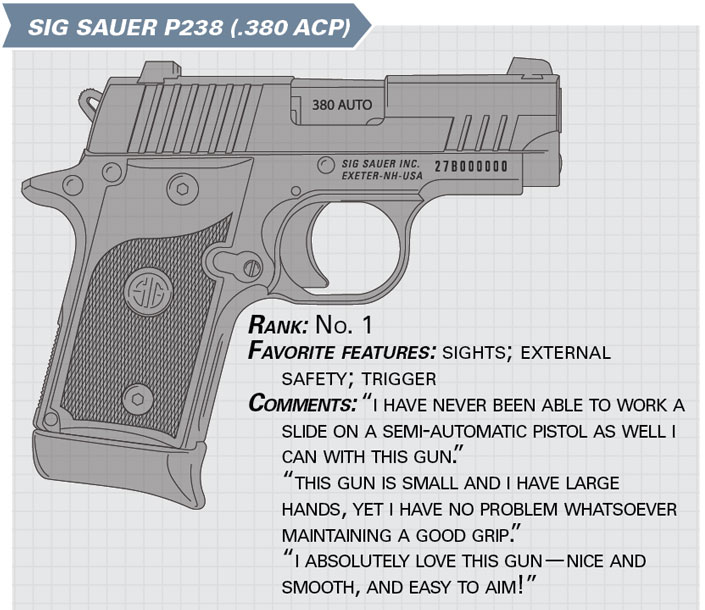
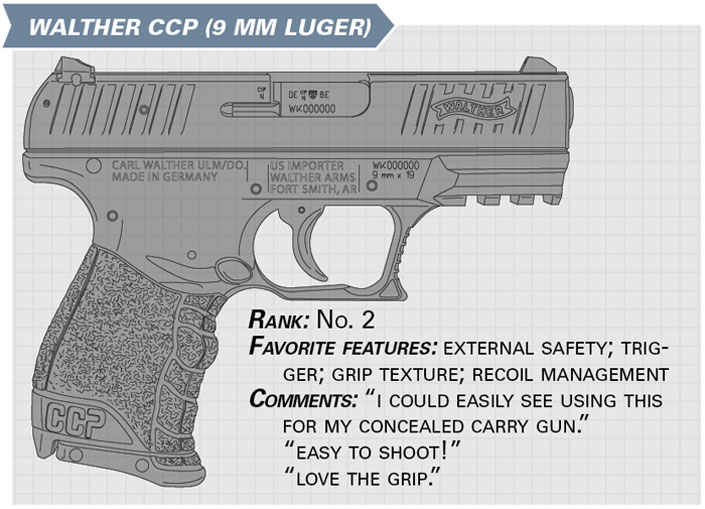

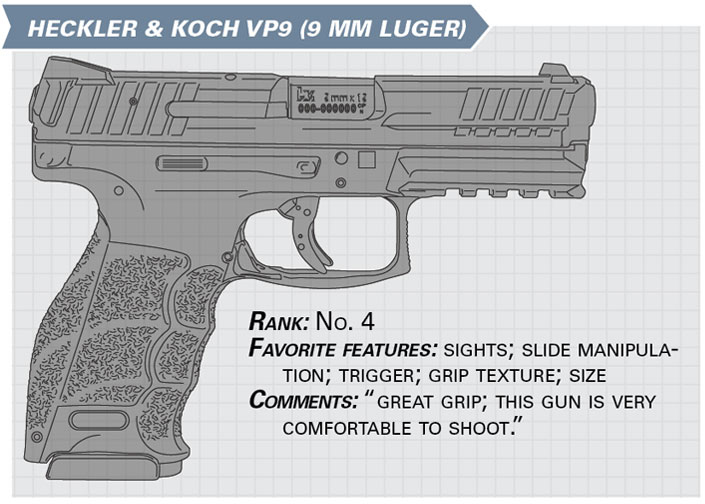
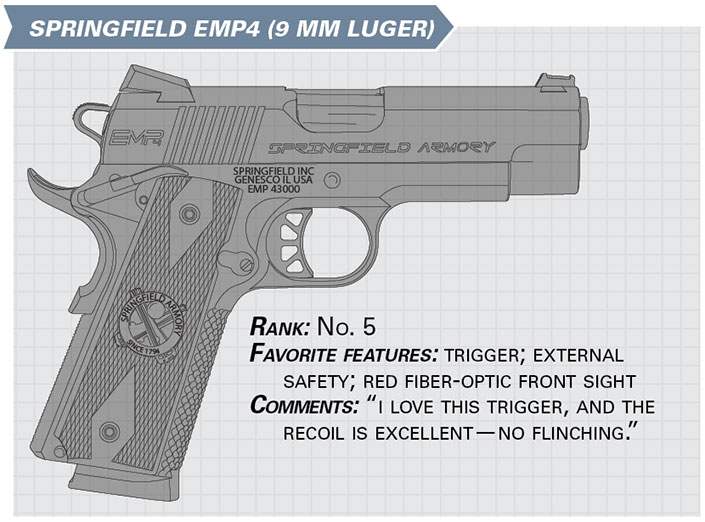
Here's how it all breaks down:











